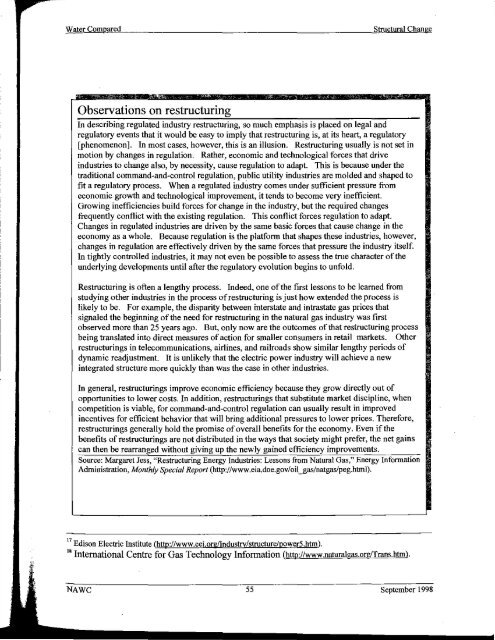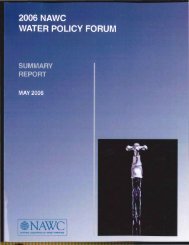BEECHER - NAWC
BEECHER - NAWC
BEECHER - NAWC
Create successful ePaper yourself
Turn your PDF publications into a flip-book with our unique Google optimized e-Paper software.
Water ComparedStructural ChangeObservations on restructuringIn describing regulated industry restructuring, so much emphasis is placed on legal andregulatory events that it would be easy to imply that restructuring is, at its heart, a regulatory[phenomenon]. In most cases, however, this is an illusion. Restructuring usually is not set inmotion by changes in regulation. Rather, economic and technological forces that driveindustries to change also, by necessity, cause regulation to adapt. This is because under thetraditional command-and-control regulation, public utility industries are molded and shaped tofit a regulatory process. When a regulated industry comes under sufficient pressure fromeconomic growth and technological improvement, it tends to become very inefficient.Growing inefficiencies build forces for change in the industry, but the required changesfrequently conflict with the existing regulation. This conflict forces regulation to adapt.Changes in regulated industries are driven by the same basic forces that cause change in theeconomy as a whole. Because regulation is the platform that shapes these industries, however,changes in regulation are effectively driven by the same forces that pressure the industry itself.In tightly controlled industries, it may not even be possible to assess the true character of theunderlying developments until after the regulatory evolution begins to unfold.Restructuring is often a lengthy process. Indeed, one of the first lessons to be learned fromstudying other industries in the process of restructuring is just how extended the process islikely to be. For example, the disparity between interstate and intrastate gas prices thatsignaled the beginning of the need for restructuring in the natural gas industry was firstobserved more than 25 years ago. But, only now are the outcomes of that restructuring processbeing translated into direct measures of action for smaller consumers in retail markets. Otherrestructurings in telecommunications, airlines, and railroads show similar lengthy periods ofdynamic readjustment. It is unlikely that the electric power industry will achieve a newintegrated structure more quickly than was the case in other industries.In general, restructurings improve economic efficiency because they grow directly out ofopportunities to lower costs. In addition, restructurings that substitute market discipline, whencompetition is viable, for command-and-control regulation can usually result in improvedincentives for efficient behavior that will bring additional pressures to lower prices. Therefore,restructurings generally hold the promise of overall benefits for the economy. Even if thebenefits of restructurings are not distributed in the ways that society might prefer, the net gainscan then be rearranged without giving up the newly gained efficiency improvements.Source: Margaret Jess, "Restructuring Energy Industries: Lessons from Natural Gas," Energy InformationAdministration, Monthly Special Report (http://www.eia.doe.gov/oil_gas/natgas/peg.html).17Edison Electric Institute (http://www.eei.org/Industrv/structure/powerS.htm).18International Centre for Gas Technology Information (http://www.naturalgas.org/Trans.html.<strong>NAWC</strong> 55 September 1998
















